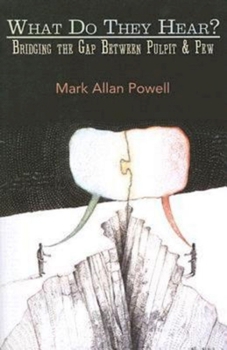What Do They Hear?: Bridging the Gap Between Pulpit & Pew
Select Format
Select Condition 
Book Overview
PREACHINGPowell provides a startling study of how differently the pastor and the congregation interpret Scripture, how this difference affects what the congregation hears in the sermon, and how to bridge this gap with equally startling practical steps. This remarkably fascinating book reveals how significant social location--such as age, gender, nationality, race, and education--is when interpreting the Bible. Illustrated with two studies, Mark Allan Powell demonstrates how this plays out most dramatically in the gulf, often quite wide, between the preacher and the congregation.Every preacher who reads this book will appreciate as never before the significance of social differences in the reception of his or her sermon, will see the unmistakable need to bridge this gap, and will receive clear instruction on how to do just that.
Format:Paperback
Language:English
ISBN:0687642051
ISBN13:9780687642052
Release Date:May 2007
Publisher:Abingdon Press
Length:107 Pages
Weight:0.70 lbs.
Dimensions:0.3" x 6.3" x 8.5"
Customer Reviews
2 ratings
How to Bridge the Gap Between Pulpit and Pew
Published by Thriftbooks.com User , 17 years ago
Mark Allan Powell's What Do They Hear? Briding the Gap Between Pulpit and Pew is a terrific resource for pastors and preachers wondering just how their people hear and respond to their sermons and to the Bible itself. A short book, What Do They Hear barely exceeds 100 pages and can be read in one sitting, but its brevity in no way damages its impact. Powell includes the results of fascinating surveys that show how clergy and laity respond differently to biblical texts, especially when it comes to empathizing with certain biblical characters over others. Take the Parable of the Prodigal Son for instance. Powell shows how Western readers typically see the story in terms of individual wastefulness and sinful living. Eastern readers see the "famine" as central to the storyline. The boy is a fool, not because of his wasteful living so much as because of his rejection of family and friends. Both readings are taken from within the text itself and are legitimate. Yet the reader's experience definitely what he/she sees within the text. Powell also includes helpful research for preachers who want to better connect with their audience. In stories about Jesus, preachers tend to empathize or cast themselves in the role of Jesus. Church members see themselves in the disciples. Perhaps the most tantalizing piece of information comes at the very end of this short book. When asked "What does this passage mean to you?" and then "What does this passage mean?," the laity did not indicate any difference in their answers. What the passage meant to them is what the passage means. The clergy, however, pointed to authorial intent when asked what the passage meant. Whether we advocate or teach "reader-response" criticism or postmodernism, our churchmembers are already there. What does this mean for the pastor? Well, Powell doesn't take us through all the implications of his research. He leaves that for us to figure out. Be warned. If you read this book, you will be thinking about its concepts for a long time!
Invaluable resource
Published by Thriftbooks.com User , 18 years ago
This is an invaluable resource for preachers who may not understand that their approach to scripture is very different from their congregations. The goal of preaching is not to make the congregants into the image of the preacher but to bridge the gap and this is what Powell does. His "studies" are very provocative and althougth they are not solid "science" they point in directions that preachers should pay attention to. His use of literary criticism is refreshing and ideas such as the social location of the hearers is important. Good preachers may intuitively know what Powell talks about but even there it is useful to see it spelled out. Finally, Powell provides some useful and practical helps to think about sermon preparation. The really important issue here is that a well crafted bibilically sound "message" may not reach the listening audience. The task of preaching is art and science and Powell finds both.






